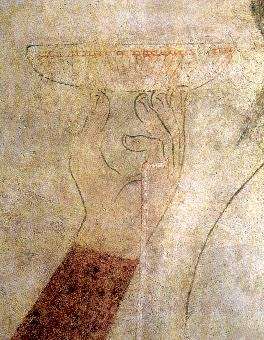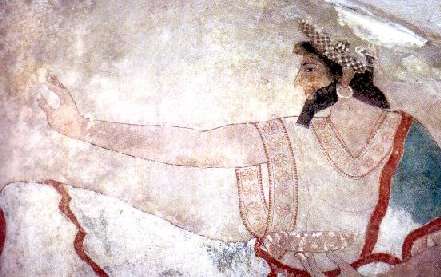|
The paintings of the Lycian-Persian tomb chamber at Karaburun near Elmali (Antalya), which may be referred to here for comparative analysis, provide a relatively well preserved sequence of scenes in the life and afterlife of the dignitary buried there about 470 BC. This local nobleman or aga had the Karaburun limestone chamber built and decorated, and paffially covered by a tumulus during his lifetime, surely following examples of other grandees in greater Lycia and Lydia. Against the rear wall of his tomb chamber stood a stone kline on which he ultimately was laid to rest in full dress and jewellery and with the silver and gold vessels needed to celebrate the continued pleasures of the symposium or banquet, well prepared and attended by servants. Above the mortal remains of the nobleman once laid out on the stone Mine is his radiant, nearly life-size image painted in fun detail, showing him enjoying a banquet and symposium as he reclines on a painted couch with a table of provisions in front. He wears Anatolian attire and Persian jewellery, for example, lion-head bracelets. He greets and summons two servants in Persian costume approaching him from the left: a fan-and towel- bearer, and a steward whose fight hand holds a wine-jar with griffinhandles; with his raised left hand he supports a lobed phiale on his fingertips, while his little finger holds the ring of a precious metal ladle.
|

Phiale and ladle by servant
|
|
The dignitary himself wearing a splendid diadem and large earrings, balances a phiale on the fingertips of his left hand, eagerly anticipating the beverage brought by the approaching steward. Behind the dignitary stands a woman offering the comfort of an alabastron and a fillet dipped in the aromatic oil. The Karaburun tomb was emptied of its contents by Roman looters, but its wall paintings preserve a vivid illustration of the ritual celebrated with the silver vessels at Ikiztepe and Toptepe, and demonstrates a harmonious combination of tomb gifts and wall paintings to fulfil the ideals of a transfer to the state of blissful permanence in afterlife.
|

Persian dignitary
|













